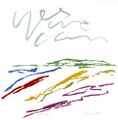File:Corita yes we can.jpg: Difference between revisions
Siterunner (talk | contribs) No edit summary |
Siterunner (talk | contribs) No edit summary |
||
| Line 7: | Line 7: | ||
<big>Come Alive! The Spirited Art of Sister Corita</big> | |||
(2020) ''Kent's place in art history has been more thoroughly revisited through major exhibitions during the last decade, and her work is held in the collections of institutions including the Museum of Modern Art and the Whitney Museum of American Art in New York. Last year, city authorities in Los Angeles, where she dedicated much of her life to teaching, named November 20 "Corita Kent Day" to mark what would have been her 101st birthday.'' | (2020) ''Kent's place in art history has been more thoroughly revisited through major exhibitions during the last decade, and her work is held in the collections of institutions including the Museum of Modern Art and the Whitney Museum of American Art in New York. Last year, city authorities in Los Angeles, where she dedicated much of her life to teaching, named November 20 "Corita Kent Day" to mark what would have been her 101st birthday.'' | ||
Revision as of 20:49, 24 February 2020
Sister Corita Kent
Come Alive! The Spirited Art of Sister Corita
(2020) Kent's place in art history has been more thoroughly revisited through major exhibitions during the last decade, and her work is held in the collections of institutions including the Museum of Modern Art and the Whitney Museum of American Art in New York. Last year, city authorities in Los Angeles, where she dedicated much of her life to teaching, named November 20 "Corita Kent Day" to mark what would have been her 101st birthday.
She began thinking about consumerism, branding and text, and how to incorporate them into her practice, which was largely figurative and spiritual. Yet she had been prescient in her approach: Believing in accessible art, she adopted silk-screening around a decade before Warhol popularized the medium.
"How do you get your message (...) into the world as fast as possible?".
"(Printmaking) is really democratic. It's something that can be done fairly quickly, and you're able to put out multiples in the world."
She joined the Sisters of the Immaculate Heart of Mary aged 18, taking the name Mary Corita Kent. After earning degrees at what is now the California Institute of the Arts and the University of Southern California... Kent taught at the art department of Immaculate Heart College in Los Angeles.
In the set of 10 rules that Kent made for art and life, number four guided her own practice and her teachings: "Consider everything an experiment."
"I think that's where you see her really look at what's happening in the world," Scott said. Two years later, Kent's red, white and blue plea "stop the bombing," against American involvement in the Vietnam War, began appearing at anti-war demonstrations.
Though Pope John XXIII had begun radically modernizing the Catholic Church in the 1960s, and Kent's own progressive sect enthusiastically embraced change, she still faced pushback for her work. The Archbishop of Los Angeles at the time, Cardinal James McIntyre, was a staunchly traditional thorn in her side, and became incensed over her 1964 print that declared: "Mary Mother is the juiciest tomato of them all" -- a reference to Del Monte's tomato sauce slogan.
Kent ultimately left the church in 1968, with her entire order later following suit to become a nondenominational congregation. With Boston as her new home, her work became more secular.
In 1969, she produced the series "Heroes + Sheroes," which asked critical questions such as, "Why not give a damn about your fellow man?" as well as more optimistic declarations like, "Hope arouses as nothing else can arouse a passion for the possible."
...her legacy: joyful, optimistic works that still ask difficult and necessary questions about human nature.
She began thinking about consumerism, branding and text, and how to incorporate them into her practice, which was largely figurative and spiritual. Yet she had been prescient in her approach: Believing in accessible art, she adopted silk-screening around a decade before Warhol popularized the medium...
"I think that there is something about her message and her stirring of hope that people really resonate with. It's something that they're searching for, and I think we've had a swell of people wanting to experience it."
~
File history
Click on a date/time to view the file as it appeared at that time.
| Date/Time | Thumbnail | Dimensions | User | Comment | |
|---|---|---|---|---|---|
| current | 18:01, 5 October 2013 |  | 484 × 494 (44 KB) | Siterunner (talk | contribs) |
You cannot overwrite this file.
File usage
The following page uses this file: